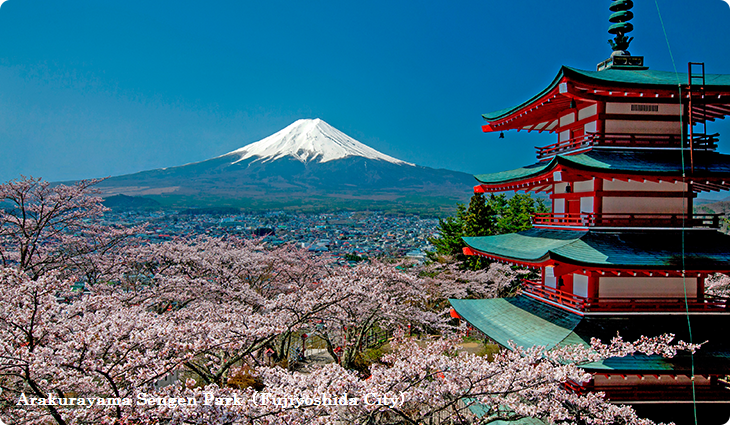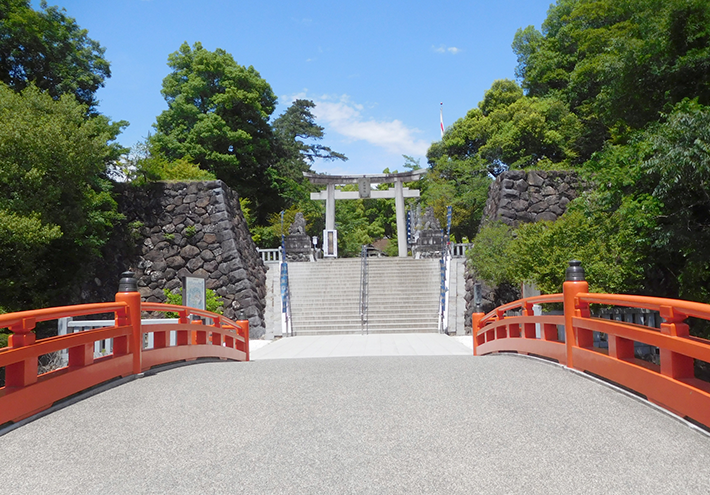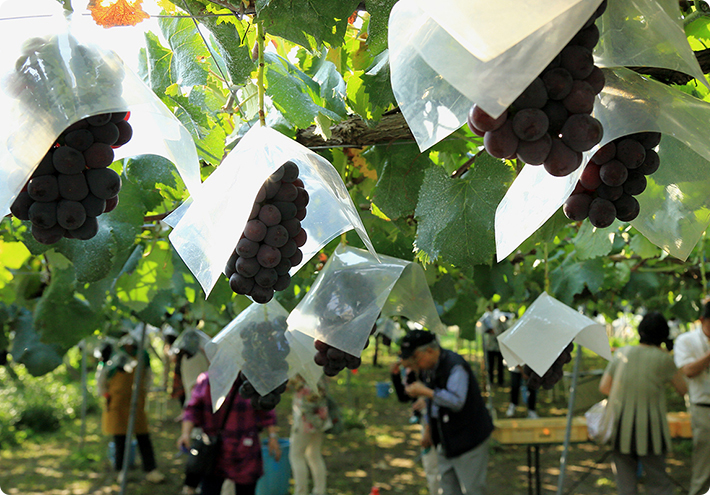

Tourist information on Yamanashi・Mt. Fuji area

This area is located in the southern part of Yamanashi Prefecture.
This area has Mt. Fuji, Japan’s highest peak, which is registered as a World Heritage Site.At the foot of Mt. Fuji, there is a mysterious wilderness born by lava flowed out of Mt. Fuji, such as Fuji Five Lakes, Aokigahara Dense woodland and Lava Cave.
Mt.Fuji・Foot of Mt.Fuji
From Shinjuku to Lake Kawaguchiko, Lake Yamanakako, Oshino Hakkai ; take “Fuji Goko Line” on Chuo highway bus
From Shinjuku to Mt.Fuji; take “Mt.Fuji 5th Line” on Chuo highway bus

Mt.Fuji is the highest mountain in Japan, with an altitude of 3,776 m. It is registered as a World Cultural Heritage in 2013 and its graceful appearance is widely known as a symbol of Japan even in foreign countries. During the mountain climbing season in summer (the mountains open on July 1st every year), it is crowded with more than 200,000 climbers. Because it is possible to reach the middle of the mountain by bus.
At the foot of Mt. Fuji, there are 25 constituent assets registered as World Cultural Heritage sites such as Fuji 5 Lakes, making the area very popular among foreign tourists.

Lake Kawaguchiko located in the center of Fuji five lakes. As the entrance of the lakes, Kawaguchiko Station and the Chuo Expressway Kawaguchiko Exit are located nearby the lake, as well as a travel hub where many people come and go.
There are many accommodation facilities including hotels, Japanese-style hotels, inns, as well as tourist facilities and shops dotted around the area.
In the lake there is the only island among the five lakes, the scenery of the Kawaguchiko Ohashi bridge to the island is great. Across the lake, you can also get a great view of Mt. Fuji.
【Access】From Shinjuku; take “Fuji-Goko Line” on Chuo highway bus, get off at “Kawaguchiko Station”

Lake Yamanakako is the closest to Mt. Fuji and the largest lake among the Five Lakes. The altitude of the lake surface is also the highest, and summer is crowded as a summer resort.
From the northern coast of the lake, there are spots where the sunrise coming up from the peak of Mt. Fuji, called “Diamond Fuji”, can be seen in November and February every year. In addition, there are parks where you can get great view of Mt.Fuji, such as “Flower Park Miyako Park”, a flower garden with Mt. Fuji in the background.
【Access】From Shinjuku; take “Fuji-Goko Line” on Chuo highway bus, get off at “Yamanakako Asahigaoka(*)”
* There are several bus stops around Lake Yamanakako. Please check the nearest bus stop.
These lakes of the Fuji Five Lakes are located at foot of northwest of Mt.Fuji. The area is filled with abundant natural resources, including Aokigahara Forest. There are lava caves such as Narusawa Hyouketsu Cave and Fugaku Fuketsu Cave where you can see the icicles that will not melt even in the summer, and you can touch magical and majestic nature with the Aokigahara Forest.

“Oshino Hakkai” is a spring water pond that emits a water source to the subsoil water of Mt. Fuji. The eight ponds dotted in villas are designated as a natural monument of the country from its beauty, also certified as part of the World Heritage Fuji configuration assets.
【Access】From Shinjuku; take “Fuji-Goko Line” on Chuo highway bus, get off at “Oshino Hakkai”
Kofu
From Shinjuku; take “Kofu Line” on Chuo highway bus

Shosenkyo is a valley located in the north part of Kofu city. You may take a walk along the path by the valley, enjoy the most beautiful valley in Japan, full of granite cliffs, oddly-shaped rocks and clean stream.
【Access】
Highway bus [Kofu Line], get off at Kofu Station.
Take a local bus at No. 4 bus stop.
Shosenkyoguchi(Approx.30 min) /Tenjin-mori(Approx.30 min)/Green Line(Approx.40 min)/ Takinoue(Approx.60 min)

Takeda Shrine is built in 1919, and was dedicated to Takeda Shingen, the famous leader of the Kai country. It is located on Tsutsujigasaki, the place where three generations of Takeda actually lived and is the largest of its kind across the whole of Japan.
【Access】
Highway bus [Kofu Line], get off at Kofu Station.
30 minutes walk/10 minutes bus from North exit of Kofu Get off at Takeda Shrine

Many kinds of fruits are grown in Yamanashi, particularly grape and peach boast the nation’s largest amount of production, and Kofu Basin is its central production area. Many people visit Yamanashi to enjoy fruit of Yamanashi widely from all over the world, especially in harvest season. The basin climate is also suitable for wine making. “Koshu wine” made from the Koshu Grape which is regarded as a unique variety of Japan, fits well with Japanese cuisine with a refreshing and elegant mouthfeel. It is tasty and widely popular.
【Access】From Shinjuku; take “Kofu Line” on Chuo highway bus

